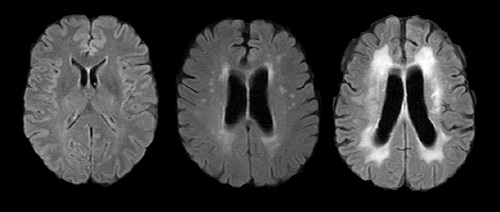
20/01/2023 - Press release
Lifestyle habits influence the DNA configuration and determine biological age. If these habits are modified, DNA ageing and, therefore, biological ageing can be slowed down.
Our lifestyle habits, the way we live, have a decisive influence on our brain's ageing. A study by the Neurovascular Research Group at the Hospital del Mar Medical Research Institute (IMIM-Hospital del Mar), published in Biology, has established a relationship between biological age, which is independent of chronological age and depends largely on our lifestyle habits, and the appearance of an indicator of brain ageing, white matter hyperintensities. These areas of the brain look different on magnetic resonance images and are indicative of a tissue that the blood has a harder time reaching.

From left to right, Jordi Jiménez-Conde and Joan Jiménez-Balado.
"A considerable part of the effect that the passage of time has on our brains is not only the result of our chronological age, based on our date of birth, but also our biological age, which explains many other non-chronological aspects", notes Dr. Jordi Jiménez-Conde, coordinator of the research group, a consultant in the Neurology Department at Hospital del Mar, and author of the study. The work paves the way for new tools that will improve patient prognosis and monitoring, making it possible to use a blood test to identify which individuals will have a greater tendency to suffer from accelerated brain ageing.
Analysed in blood and through magnetic resonance imaging
The researchers looked at data from 247 stroke patients who underwent MRI scans to establish the volume of white matter hyperintensity in their brains. Biological age was also determined in blood samples by analysing the degree of DNA methylation, which changes depending on external factors such as lifestyle. In this way, it was possible to demonstrate for the first time how "biological age, the ageing of the body, is directly associated with brain ageing independently of chronological age", explains Dr Jiménez Conde.

Magnetic resonance image showing white matter hyperintensities associated with the degree of brain aging.
In fact, biological age explains 42.7% of brain ageing as measured by the presence of white matter hyperintensity. As Dr. Joan Jiménez-Balado, a postdoctoral researcher in the Neurovascular Research Group at the IMIM-Hospital del Mar and author of the study, explains, "We must continue to study the effect that genetics has on these brain lesions, as this may help us to better understand the biological mechanisms involved in brain ageing. By the same token, in future studies it will be very interesting to use the new computer approaches that allow us to classify white matter hyperintensities according to aspects such as their location and to see if, for example, we are lumping these lesions together when they are actually associated with different causes depending on the space they occupy."
In this sense, a high incidence of white matter hyperintensity is associated with various pathologies, such as non-specific cognitive impairment, gait disturbances and a poorer prognosis in terms of the brain's ability to recover from any pathology that affects it. Its volume increases with age and is not reversible. However, lifestyle changes could act on biological ageing and slow down DNA ageing, potentially delaying the increase of these lesions in brain tissue and decelerating the brain's ageing process.
Reference article
Jiménez-Balado, J.; Giralt-Steinhauer, E.; Fernández-Pérez, I.; Rey, L.; Cuadrado-Godia, E.; Ois, Á.; Rodríguez-Campello, A.; Soriano-Tárraga, C.; Lazcano, U.; Macias-Gómez, A.; Suárez-Pérez, A.; Revert, A.; Estragués, I.; Beltrán-Mármol, B.; Medrano-Martorell, S.; Capellades, J.; Roquer, J.; Jiménez-Conde, J. Epigenetic Clock Explains White Matter Hyperintensity Burden Irrespective of Chronological Age. Biology 2023, 12, 33. https://doi.org/10.3390/biology12010033%20
© Institut Hospital del Mar
d'Investigacions MèdiquesLegal Notice and Privacy Policy | Cookie Policy | Site Index | Accessibility | Find Us | Contact